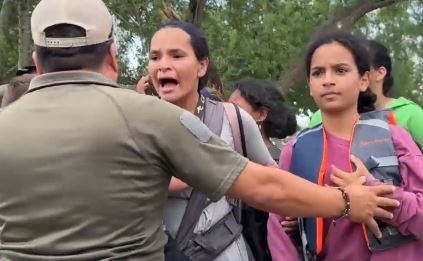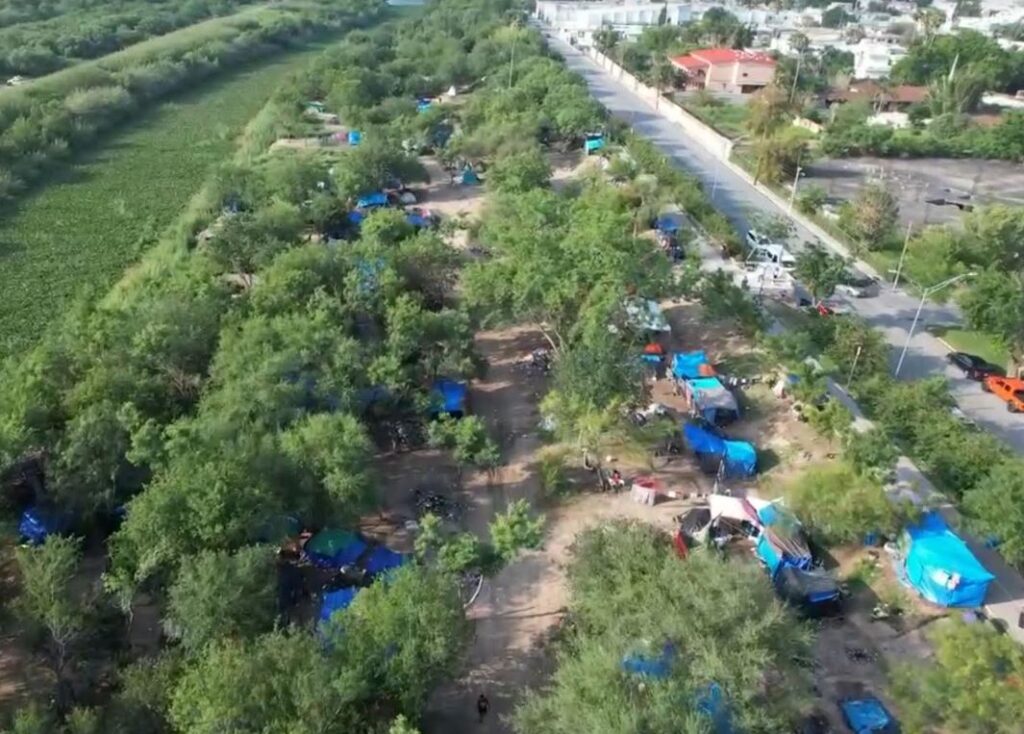Hint: Biden and Mexico’s Obrador have arranged an out-of-view crackdown that could endure through the U.S. presidential election and serve them both politically
By Todd Bensman as published January 17, 2024 by the Center for Immigration Studies

AUSTIN, Texas — Nothing in the American experience has ever compared to the 10,000-14,000 illegal crossings every day the last several months that afflicted major American cities or those poor federal government souls who must manage the U.S. southern border.
But November’s and December’s latest “newest” record-smashing crossings, which exacerbated an already significant political liability to President Biden’s November reelection bid, were falling fast by New Year’s Day. And they’re still dropping.
Daily Border Patrol encounters of illegally crossing foreign nationals in the first weeks of January, in fact, were down by up to 70 percent from the 12,000 and 14,000 per day of recent weeks, to a still managerially catastrophic 4,000 and 5,000, according to government data shared confidentially with me.
Bensman discusses on the Sebastian Gorka Show
What led to those numbers dropping from ionospheric heights the national media had no choice but to cover in a presidential election year? Will it last? Is this one real?
It helps to know that the falling numbers neatly coincide with recent shuttle diplomacy to Mexico City about the (political) crisis by Biden personally and his Secretary of State Antony Blinken on December 22 and then DHS Secretary Alejandro Mayorkas and Blinken on December 27. The second meeting produced a joint communique lacking any useful details about the horse-trading, as my colleague Andrew R. Arthur has still managed to expertly analyze.
“I don’t believe in coincidences,” Arthur told me. “There’s a deal. We just don’t know what the deal is.”
But the hardly reported or analyzed on-the-ground fruits of all this cannot go ignored for much longer because media visuals of the chaos have loomed so very large in Republican political campaigning — as in ongoing negotiations with Republican senators holding up Ukraine war funding and in House negotiations over raising the debt ceiling.
The fact that the camera-loving high numbers at the heart of all this are dropping so precipitously now warrants some discussion.
Bensman Discusses with Steve Bannon in the War Room
Mexico Is Cracking Down in Old and New Ways to Slow the Flow
In a nutshell summary of Mexico’s doings, according to my own content analysis of Mexican media, forces under control of Mexico’s central government are rounding up immigrants in the country’s north and shipping them by bus and airplane to southern cities like Tapachula in Chiapas State (on the border with Guatemala) and Villahermosa in Tabasco State. They are all expected to go home or stay put alongside those continuing to enter from Guatemala.
They’ll be held back to wait for a molasses-slow bureaucracy to approve individual travel papers. Tens of thousands are filling those southern provinces now.
Meanwhile, federal forces are installing new road checks to hem them in, a la the Gaza Strip, and in the northern provinces to catch, return, and deter runners still getting through.
Probably to instill an enforcement vibe, Mexico also appears to be ramping up air deportations from its rapidly filling southern provinces that may send increasing numbers of uncooperative, rebellious, or repeat attempting immigrants caught in this southern bureaucracy back to distant home countries.
The bottle-necking strategy is actually nothing new and easily undone; I’ve been reporting on it since 2019 (See “Video Report: How Trump’s Policies Ended the Mass Migration Crisis on Mexico’s Southern Border – For Now”). But the Biden administration has long let Mexico slide on it so long as Mexico did it in a way that American TV cameras couldn’t see (See “Mexico’s Duplicitous ‘Ant Operation’ Moved Tens of Thousands of the U.S. Border Sight Unseen — and Will Again Through 2022”).

To eliminate another obvious draw, Mexican authorities have emptied and then bulldozed at least one longstanding migrant camp, the sprawling one in Matamoros across the Rio Grande from Brownsville and reportedly dug deep anti-pedestrian trenches to deny further easy access to popular crossings there. Other ad hoc camps also are probably scraped away by now, too, or soon will be if this continues.
Perhaps one of Mexico’s most impactful slow-down measures is that, finally, it is doing something about “La Bestia”, the system of cargo trains that have super-powered the Biden border crisis for three years running by transporting hundreds of thousands of migrants from deep southern Mexico to its northern border cities.
The Trains
In January 2023, I returned from a field research trip and published dispatches establishing that La Bestia was quietly enabling the illegal migration crisis at the U.S. southern border, that Mexico was allowing it to run unfettered, and that Biden, unlike prior presidents like Obama, had never pressured Mexico to stop the use of the trains by migrants.
Bensman Discusses with Glenn Beck
“Mexico is feeling no pressure to block this stream of human cargo,” I wrote in a January 19, 2023, report for The Daily Mail about the renewed widespread use of the trains. “There was no public mention of La Bestia before, during, or after President Biden’s talks with Mexican President Andrés Manuel López Obrador [AMLO for short] during his recent visit to Mexico City.”
Three years too late, the administration apparently has seen the light and shown it to AMLO.
Mexican media reports that Mexico City has ordered its military to blockade railyards like the ones I visited in my reporting in Monterrey, El Torreon, and Piedras Negras across from Eagle Pass, to stop migrating foreigners from boarding. They’re also rousting immigrants already on freight trains that briefly stop or slow down en route to northern Mexican cities.
“Migrants report finding it extremely difficult to reach [northern Mexico], as authorities, including immigration and the National Guard, stop their progress along train tracks,” a January 10 story in the Chihuahua Herald reported.
People in popular northern railway destination cities like Juarez, across from El Paso, have noticed the sharp change.
“After the arrival of thousands of migrants aboard cargo trains in Ciudad Juarez during the last quarter of 2023, a train with around five people headed to the border was observed,” wrote El Diario on January 12. “The small group traveling on a wagon was photographed by a resident of that town, who at the end of last year witnessed the passage of different trains with hundreds of people towards this border.”
According to Mexican media, this is part of a broader “agreement” signed by Mexico’s immigration service and the U.S. Border Patrol to also block northbound immigrants on public roads.
Immigrant Roundups in the North, Renewed Blockade in the South
The new year brought new scenes in big Mexican border cities like Piedras Negras across from the recently swamped Eagle Pass, Texas, and the city of Juarez, the same ones where jam-packed trains of a month ago reportedly now arrive nearly empty.
“Agents from the National Migration Institute can be seen chasing migrants from the banks of the river who do not give up and are waiting for the moment to be able to cross to the U.S. side,” The Juarez Herald reported in a January 11 story headlined “Military Prevents Migrant Families from Crossing to the U.S.”
Many of those whom authorities manage to catch end up on highly deterring flights to Villahermosa or Tapachula or even all the way back to home countries, an action that, if a recent history of these is any indication, can significantly retard repeat efforts to reach the American border. Round-up operations seem ubiquitous in northern Mexico these days — for how long no one can say.
“A convoy of 10 units from the National Migration Institute and the Municipal Public Security Secretariat traveled along the banks of the Rio Grande, which remained without the presence of migrants,” El Diario explained for a January 10 video report. “According to the municipal authority, the federal government sent them a letter to request their security support to carry out a tour of the border limits while the INM reported that the edge of the Rio Grande is a permanent control point.”
In the first 10 days of January, the outlet noted, irregular daily crossings of migrants to the United States have dropped by more than half, from 1,095 each day in December to 468.
The forced exodus from Piedras Negras (across the river from from Eagle Pass) began just before Christmas on the eve of the Biden state visit. By December 31, at least 22 flights and as many as 30 flights departed from that city to Mexico’s south, according to the migrant advocacy group Witness to the Border, which tries to track them.
Orders for the flights from Piedras Negras came from on high in Mexico City, Diario de Tabasco reported, and were complemented by 10 buses of migrants per day from that city.
Illegal traffic into Eagle Pass today continues, but in fractional volumes of what they were in the fall.
“Notably”, Witness at the Border reported in its December release, “Mexico also reinstated deportation flights to Venezuela with two flights.”
The in-Mexico flights and busing are happening in many other northern Mexican border cities as well. Witness at the Border reports southbound flights from towns all along the border, from Tijuana, at the border’s most western edge, all the way to Matamoros near the Gulf of Mexico.
In a story headlined “Truncated American Dream: Learn about Miguel’s Story”, the Tabasco Herald described how Mexican immigration agents rounded up Guatemalan Don Miguel and his six children from a long-standing migrant camp in Matamoros on December 31.
They shipped him to Villahermosa, where he has requested a ride back to Guatemala for lack of food or money to wait in southern Mexico.
He was far from the only one pulled from the sprawling camp in Matamoros, one that has been in place for at least five years and which I know well from a chaotic week I spent reporting in and around it in May 2023. (See “Video Updates: Mexican Border in Chaos as Title 42 Ends”).
Reducing Shelter Space
Drawing little or no U.S. media coverage was the destruction of the long-standing Matamoros encampment, a staging area for as many as 5,000 migrants at a time wanting to cross to Brownsville.
After nearly the entire encampment’s 2,000 migrants splashed over into Brownsville in December, when the Americans were overwhelmed nearly everywhere, Mexico sent in heavy equipment on December 29 to scrape away almost the whole shantytown, this Telemundo video report shows.
It was done “under U.S. pressure”, one Mexican newspaper said.
In another move, the Mexicans dug trenches in spots along its side of the river to deter immigrant crossers. Many other makeshift camps have formed along the river, drawing non-governmental organizations that have helped sustain the border-crossers in the camp until they can cross. News reporting was insufficient to show how many of these the Mexican government also demolished.
The decline so far in January also coincides with some other Biden administration moves in countries further south. The administration, for instance, shuttered short-cutting, $4,000 per one-way flights from Haiti and Cuba to Nicaragua that enabled tens of thousands to cross the American border, until the U.S. State Department in October imposed visa restrictions on charter flight operators and threatened to prosecute all involved for human smuggling.
Will Any of This Last?
Biden’s motivating drive in reopening migration-related diplomacy with Mexico amid days of 14,000 apprehensions that ended with a historic 300,000 in December is to get those giant numbers and terrible visuals out of the headlines ahead of an election many predict will be won or lost on thin margins.
A source close to U.S. Customs and Border Protection’s foreign operations division in Mexico told me one element of the Biden proposal is that AMLO slow the flow only until after the November election. That’s uncorroborated, though plausible.
But what would AMLO get in exchange for bearing this so long? The Mexican president has called for $20 billion to be shared among his country and some others, for starters, according to media reports.
The cash is probably the main “get” for AMLO to grant this political favor, although he tacked on pie-in-the-sky asks like having the United States legalize millions of Hispanics illegally in the U.S., suspend the blockade of Cuba, and remove sanctions against Venezuela.
It’s unclear if any cash has changed hands yet. If not, AMLO’s moves so far would amount to a demonstration of what he can do for Biden to jumpstart some cash transfers or other favors later.
Or else.
AMLO’s Affinity for Double-Crossing Biden vs. His Fear of Trump
Feeding carrots to AMLO to slow the flow has proven short-lived compared to when Trump threatened to whack AMLO with ruinous trade tariffs if he did not help slow the flow. It’s little wonder why AMLO would much prefer Biden.
AMLO has double-crossed Biden on the carrots dating to Biden’s earliest months in office, when fresh-faced administration officials offered billions in exchange for bottling migrants up in southern border town of Tapachula, keeping a Trump-era strategy.
After taking the cash, AMLO stabbed Biden in the back in September 2021 by ordering the release and northward busing of 15,000 Haitians who were rioting and causing big trouble in Tapachula — so they wouldn’t get in the way of upcoming “El Grito” street parties. Those Haitians went on to create the infamous “Del Rio” migrant camp crisis that made international headlines for many days. (See “Why the Huge Illegal Alien Camp Formed in Del Rio” .)
In the years since, AMLO has shown only contempt for his slow-roll commitment to Biden; he just changed the tactics a little after the Del Rio migrant camp fiasco.
As I have repeatedly reported, AMLO switched to the “ant operation” strategy, which entailed releasing tens of thousands of troublesome migrants from Tapachula captivity but by spreading them out across a dozen northern provinces so that they were harder to notice.
The only hope that any horse-trading that only involves Biden carrots will last is AMLO’s fear of a Trump return with his big stick that weighs on him more than the pain of the domestic turmoil.
“I do think we’ll start to see riots with the Haitians and Africans in Tapachula,” Christopher Landau, Trump’s ambassador to Mexico told me. “If they’re effective in keeping them bottled up down there in Tapachula, where it’s pretty isolated from the rest of Mexico, there might not be a lot of political pressure” on AMLO to release them in ant operations.
“So, if Mexico wants to do this, it might not be that hard,” Landau said. “I think it can last through the election.”
But on second thought, Landau added, “I just don’t know.”
